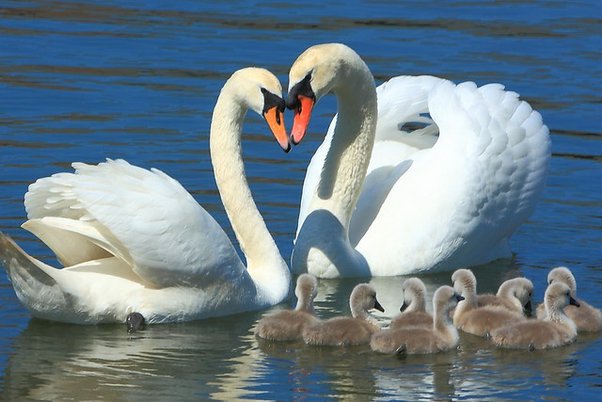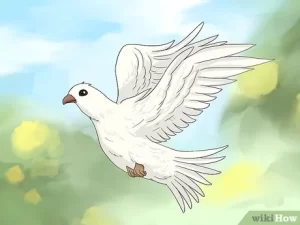
Understanding Monogamy in Birds
Definition of Monogamy
Monogamy in birds refers to a mating system where a male and a female form a pair bond, often for the duration of a breeding season or for life. While many bird species are socially monogamous, meaning they pair for at least one breeding season, true lifelong monogamy is less common.
Prevalence of Monogamous Behavior
Research indicates that approximately 90% of bird species exhibit some form of monogamous behavior. However, many of these species may not remain with the same partner for life. In fact, studies have shown that in many species, a significant percentage of offspring are not sired by the social mate, indicating that some birds engage in extra-pair copulations.
Reasons for Monogamous Pair Bonds
Birds that mate for life often do so for several reasons:
- Parental Investment: Raising young requires significant effort and resources. A stable pair bond allows both parents to share responsibilities in incubating eggs and feeding chicks.
- Territorial Defense: A bonded pair can effectively defend their territory from intruders, ensuring a safe environment for their offspring.
- Reduced Stress: Long-term partnerships can lead to reduced stress during the breeding season, as established pairs are familiar with each other’s behaviors and needs.
Characteristics of Birds That Mate for Life
1. Physical Traits
Birds that mate for life often exhibit physical traits that enhance their bond:
- Similar Size: Many monogamous birds are similar in size, which may facilitate cooperative behaviors such as nest building and feeding.
- Distinctive Plumage: In some species, males display bright plumage during the breeding season to attract females. However, in long-term pairs, both sexes may exhibit similar coloration to reinforce their bond.
2. Behavioral Traits
Behavioral characteristics play a crucial role in the formation and maintenance of pair bonds:
- Courtship Displays: Many birds engage in elaborate courtship rituals that include singing, dancing, and gift-giving to attract and maintain their mate.
- Mutual Grooming: Preening is common among monogamous birds, as it strengthens their bond and helps maintain feather health.
- Cooperative Parenting: Lifelong partners often share parenting duties, which can include building nests, incubating eggs, and feeding chicks.
3. Social Structure
Monogamous birds often have specific social structures that support their pair bonds:
- Strong Pair Bonds: Once a pair forms, they often remain together for life, raising multiple broods together.
- Group Living: Some species, like geese and swans, live in family groups, which can provide additional support during the rearing of young.
Examples of Birds That Mate for Life
Below is a table highlighting some notable bird species known for their long-term monogamous relationships:
| Bird Species | Description | Habitat | Notable Behavior |
|---|---|---|---|
| Bald Eagle | Majestic birds of prey known for their large nests. | Near water bodies | Return to the same nest each year. |
| Swans | Elegant waterfowl often seen in pairs. | Lakes and rivers | Perform synchronized swimming and neck entwining. |
| Albatross | Large seabirds known for their long-distance flying. | Open ocean | Engage in elaborate courtship displays. |
| Sandhill Crane | Tall birds known for their dancing displays. | Wetlands | Perform intricate courtship dances. |
| Macaroni Penguin | Colorful penguins known for their unique markings. | Coastal regions | Perform ecstatic displays upon reunion. |
| California Condor | Large scavengers with a wingspan of up to 10 feet. | Forests and mountains | Fly together and choose nesting sites collaboratively. |
| Barn Owl | Nocturnal birds known for their distinctive calls. | Open fields and woodlands | Engage in vocal courtship and gift-giving. |
| Lovebirds | Small, colorful parrots known for their affection. | African savannas | Form strong pair bonds and engage in mutual grooming. |
Detailed Look at Selected Species
1. Bald Eagles
Bald eagles are known for their impressive size and striking appearance. They mate for life, often returning to the same nest year after year. Their nests can be enormous, sometimes weighing over a ton. Both parents share responsibilities in raising their young, which strengthens their bond.
2. Swans
Swans are iconic symbols of love and fidelity. They are known for their graceful movements and elaborate courtship displays, which include synchronized swimming and neck entwining. Swans typically mate for life, and when one partner dies, the surviving swan may take a long time before finding a new mate.
3. Albatross
Albatrosses are known for their long wingspans and remarkable flying abilities. They engage in complex courtship rituals that can last several years before forming a pair bond. Once paired, they raise their young together, often traveling thousands of miles in search of food.
4. Sandhill Cranes
Sandhill cranes are known for their elaborate courtship dances, which involve jumping, bowing, and calling. These displays help strengthen their pair bonds. Sandhill cranes are highly social and often form family groups that assist in raising young.
5. Macaroni Penguins
Macaroni penguins are famous for their distinctive yellow crest feathers. They perform ecstatic displays to greet their partners after being apart. These displays involve puffing up their chests and making gurgling sounds. Both parents share the responsibility of caring for their chicks.
6. California Condors
California condors are among the largest flying birds in North America. They mate for life and engage in courtship flights, where they soar together. If a pair is unsuccessful in breeding, they may separate but typically remain monogamous.
7. Barn Owls
Barn owls are known for their heart-shaped faces and haunting calls. They engage in vocal courtship and often bring gifts of prey to their mates. Once paired, they remain together for life, raising multiple broods.
8. Lovebirds
Lovebirds are small, colorful parrots that are known for their affectionate behavior. They form strong pair bonds and engage in mutual grooming, which reinforces their connection. Lovebirds are social animals and thrive in the company of their partners.
The Science Behind Lifelong Pair Bonds
Genetic and Evolutionary Factors
Research suggests that genetic factors may play a role in the formation of lifelong pair bonds. Some studies indicate that certain genes associated with social behavior may influence monogamous tendencies in birds.
Environmental Influences
Environmental factors, such as habitat availability and food resources, can also impact mating behaviors. In stable environments with ample resources, birds may be more likely to form long-term pair bonds.
Social Learning
Birds learn from their experiences and the behaviors of their parents. Young birds may observe their parents forming strong bonds, influencing their own mating strategies later in life.
Conservation Implications
Importance of Monogamous Species
Birds that mate for life often play vital roles in their ecosystems. Their stable pair bonds contribute to successful breeding and the maintenance of healthy populations. Conservation efforts aimed at protecting these species can have significant ecological benefits.
Threats to Monogamous Birds
Monogamous bird species face various threats, including habitat loss, climate change, and pollution. Protecting their habitats and ensuring sustainable practices are essential for their survival.
Conservation Strategies
Conservation organizations work to protect monogamous bird species through habitat restoration, public education, and legal protections. Engaging local communities in conservation efforts can also promote awareness and support for these species.
FAQ Section
What does it mean for birds to mate for life?
Mating for life in birds refers to a long-term pair bond between a male and female, often lasting until one partner dies. These bonds are typically formed for practical reasons, such as shared parenting and territory defense.
Which birds are known to mate for life?
Some well-known birds that mate for life include bald eagles, swans, albatrosses, sandhill cranes, macaroni penguins, California condors, barn owls, and lovebirds.
Why do some birds form lifelong pair bonds?
Birds form lifelong pair bonds primarily for parental investment, territorial defense, and reduced stress during breeding seasons. A stable partnership allows both parents to share responsibilities in raising young.
Are all birds monogamous?
No, while approximately 90% of bird species exhibit some form of monogamous behavior, many do not remain with the same partner for life. Some species may change partners each breeding season.
What are the conservation implications for monogamous bird species?
Monogamous bird species play vital roles in their ecosystems, and their stable pair bonds contribute to successful breeding. Conservation efforts aimed at protecting these species are essential for maintaining healthy populations and ecosystems.For more detailed information on birds that mate for life, you can visit the Wikipedia page on Bird Mating Systems. This comprehensive overview of birds that mate for life highlights their characteristics, behaviors, and the importance of these relationships in the context of conservation. Understanding these aspects is crucial for promoting awareness and ensuring the survival of these remarkable species.


